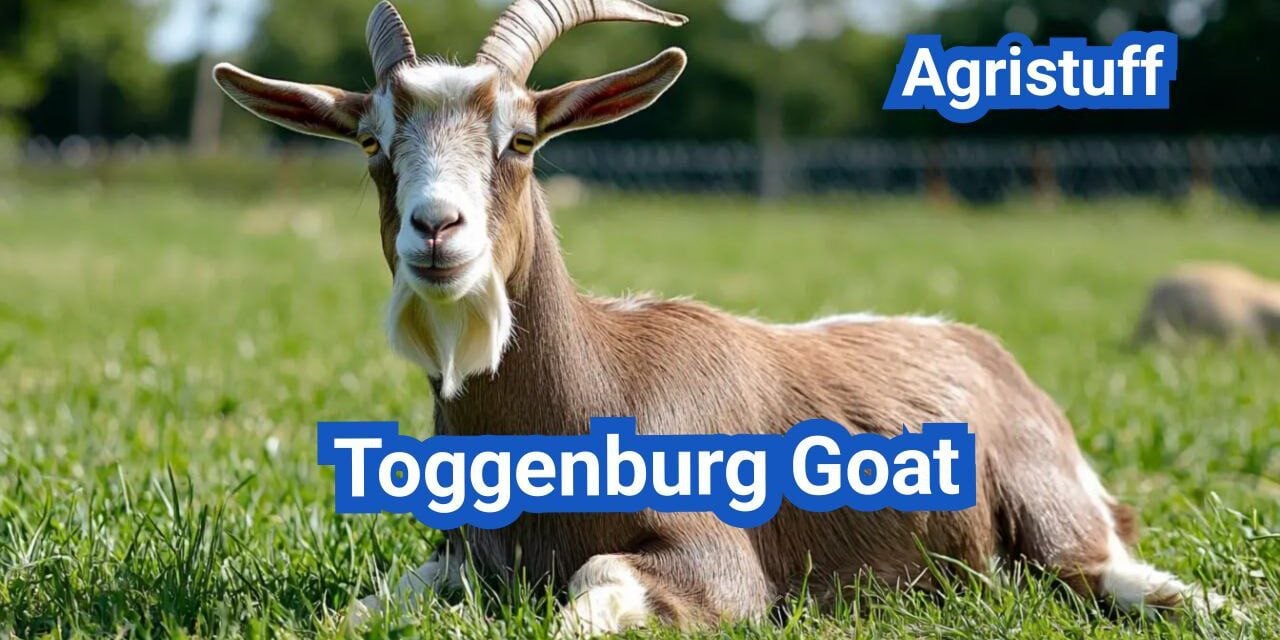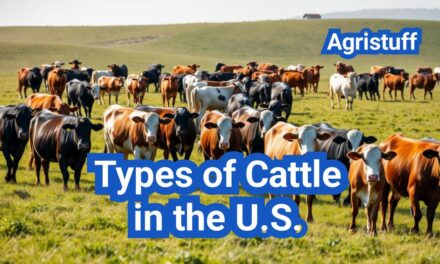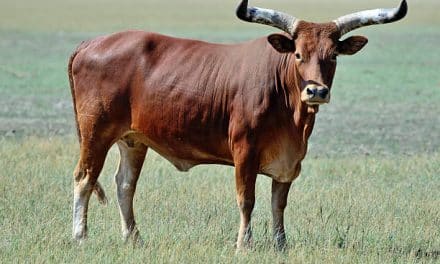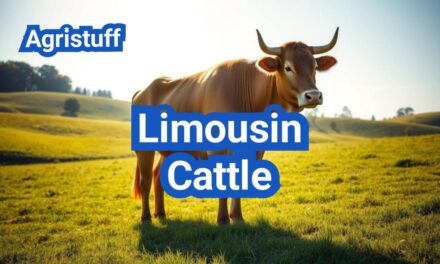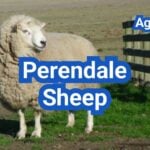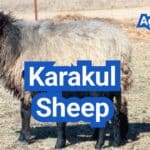The Toggenburg goat is one of the most recognized dairy goat breeds worldwide, originating from the Toggenburg region of St. Gallen, Switzerland. With a rich history, this breed has become a staple in dairy farming.
Known for its high milk production and hardiness, the Toggenburg goat has been widely adopted across the globe. This article will delve into the history, origin, characteristics, breeding practices, and various uses of the Toggenburg goat, providing a comprehensive overview for dairy farmers and enthusiasts alike.
Key Takeaways
- Origin of the Toggenburg goat breed
- Characteristics of Toggenburg goats
- Breeding practices for Toggenburg goats
- Uses of Toggenburg goats in dairy farming
- Significance of Toggenburg goats in the dairy industry
The Rich History and Origin of Toggenburg Goats
Originating in the 17th century in the Toggenburg Valley, the Toggenburg goat is one of the oldest recognized dairy goat breeds worldwide. This heritage has endowed the breed with exceptional dairy production capabilities that have been refined over centuries.
Swiss Beginnings in the Toggenburg Valley
The Toggenburg Valley in Switzerland is the birthplace of the Toggenburg goat breed. The unique geography and climate of this region played a significant role in shaping the breed’s characteristics. The valley’s fertile pastures and temperate climate allowed early farmers to develop a hardy, productive dairy goat.
The breed’s early development was influenced by the local farming practices and the need for a reliable dairy animal. Over time, selective breeding enhanced the Toggenburg goat’s dairy production traits, making it a prized breed among dairy farmers.
Development as the Oldest Known Dairy Goat Breed
As one of the oldest known dairy goat breeds, the Toggenburg goat has a history that spans centuries. Its longevity as a breed is a testament to its robustness and adaptability. The breed has been continuously improved through careful breeding practices, ensuring its status as a premier dairy goat.
The Toggenburg goat’s significance extends beyond its dairy capabilities; it has also played a crucial role in the development of other dairy goat breeds. Its influence can be seen in many modern dairy goat breeds that have been developed from or crossed with Toggenburg goats to enhance their dairy production.
Toggenburg Goat Characteristics and Appearance

The Toggenburg breed is characterized by its sturdy physique and unique coloring, which sets it apart from other dairy goat breeds. This breed has been developed over centuries to be robust and productive, with a focus on its dairy capabilities.
Size and Weight Standards
Toggenburg goats are known for their medium to large size. They typically stand between 66-85 cm tall at the shoulder. Their weight ranges from 55-68 kg, with does being generally smaller than bucks. This size and weight range contribute to their sturdy build, making them well-suited for dairy farming.
Distinctive Color and Markings
One of the most distinctive features of Toggenburg goats is their coloring. They have a brown coat with white markings, particularly on their face, legs, and sometimes their belly. The white markings can vary in extent but are a key identifying feature of the breed. Their coat is typically short to medium in length, requiring minimal grooming.
Physical Features and Conformation
Toggenburg goats have a well-proportioned body with a strong, straight back and a deep, well-sprung ribcage. Their udders are well-formed and capacious, which is essential for their dairy production capabilities. The breed has a relatively long neck and legs, contributing to their overall sturdy appearance. Their ears are erect and alert, indicating good health and vigor.
The conformation of Toggenburg goats is crucial for their dairy production. Their well-structured body and udder conformation make them efficient milk producers. Overall, the physical characteristics of Toggenburg goats make them a valuable breed for dairy farming.
Temperament and Behavior of Toggenburg Goats
The temperament of Toggenburg goats is one of their most appealing characteristics, showcasing their adaptability and social behavior. These goats are known for their friendly and curious nature, which makes them an excellent addition to many farms and homesteads.
Personality Traits
Toggenburg goats are characterized by their friendly and outgoing personalities. They are highly curious and often enjoy interacting with humans, making them a pleasure to manage. Their intelligence and problem-solving abilities are notable, as they can often figure out how to access feed or escape from enclosures if not properly secured.
One of the key personality traits of Toggenburg goats is their calm demeanor. They are generally not as skittish or nervous as some other breeds, which makes them easier to handle, especially for inexperienced farmers or those new to goat keeping.
Social Behavior with Other Animals
Toggenburg goats are social animals that thrive in the company of other goats and can get along well with other farm animals. Their social behavior is characterized by a hierarchical structure, with dominant goats leading the way. However, they are not typically aggressive and can coexist peacefully with other breeds.
When introducing Toggenburg goats to other animals, it’s essential to do so gradually to prevent stress and conflict. With proper introduction and management, Toggenburg goats can be an integral part of a diverse farm ecosystem.
| Personality Trait | Description |
|---|---|
| Friendly Nature | Toggenburg goats are known for their friendly and outgoing personalities, making them enjoyable to be around. |
| Curiosity | These goats are highly curious, often exploring their surroundings and investigating new objects or people. |
| Intelligence | Toggenburg goats are intelligent and capable problem solvers, which can sometimes lead to mischief if not properly managed. |
“Toggenburg goats are known for their gentle disposition and are often described as being ‘dog-like’ in their behavior, following people around and enjoying human interaction.”
In conclusion, the temperament and behavior of Toggenburg goats make them an excellent choice for a variety of farming and homesteading operations. Their friendly, curious, and social nature, combined with their intelligence and adaptability, contribute to their popularity among dairy goat breeders.
Milk Production Capabilities
The Toggenburg goat is renowned for its impressive milk production capabilities. As one of the oldest dairy goat breeds, Toggenburgs have been selectively bred for their ability to produce high volumes of quality milk.
Average Milk Yield Per Day
Toggenburg goats are known for their consistent milk production, with an average annual yield ranging from 777 kg to over 1000 kg. To put this into perspective, a Toggenburg goat can produce between 2.1 to 2.7 kg of milk per day during their lactation period, which typically lasts around 305 days.
This level of production makes them an attractive choice for dairy farmers. Their ability to maintain a relatively high milk yield throughout their lactation period is a testament to their hardiness and productivity.
Milk Fat Percentage and Quality
The milk fat percentage of Toggenburg goats typically ranges between 3.1% and 3.5%. This is within the desirable range for producing high-quality dairy products such as cheese, butter, and yogurt.
The quality of Toggenburg milk is highly regarded due to its rich composition and suitability for various dairy applications. The milk is not only abundant but also of high quality, making Toggenburg goats a valuable asset for dairy operations.
Comparison with Other Dairy Goat Breeds
When compared to other dairy goat breeds, Toggenburgs hold their own in terms of milk production. For instance, while Saanen goats may produce slightly more milk, Toggenburgs offer a more consistent production level throughout their lactation.
| Breed | Average Annual Milk Yield (kg) | Milk Fat Percentage |
|---|---|---|
| Toggenburg | 777 – 1000 | 3.1 – 3.5 |
| Saanen | 800 – 1100 | 3.0 – 3.5 |
| Alpine | 700 – 1000 | 3.2 – 3.8 |
This comparison highlights the competitive edge of Toggenburg goats in the dairy market, making them a popular choice among dairy farmers.
Setting Up Housing for Toggenburg Goats

Proper housing is crucial for the health and well-being of Toggenburg goats. Providing a suitable environment involves several key elements that ensure the goats are protected, comfortable, and able to thrive.
Toggenburg goats, like other dairy breeds, require adequate shelter to protect them from extreme weather conditions. The shelter should be well-ventilated to prevent respiratory issues and dry to keep the goats comfortable.
Shelter Requirements
The shelter for Toggenburg goats should be designed with their specific needs in mind. It should be spacious enough to accommodate all the goats comfortably, with enough room for feeding and milking stations if applicable.
Key shelter requirements include:
- Adequate ventilation to prevent respiratory problems
- Protection from drafts and extreme temperatures
- Easy cleaning and maintenance
- Enough space for the number of goats being housed
Fencing and Outdoor Space Needs
Fencing is a critical aspect of housing Toggenburg goats, as it ensures their safety and prevents escape. The fencing should be sturdy and at least 5 feet tall to contain the goats effectively.
Outdoor space requirements include:
- Sufficient grazing area, as Toggenburg goats are browsers
- Space for exercise to maintain the goats’ physical health
- Adequate shade and shelter from the elements
Here’s a comparison of different fencing types for Toggenburg goats:
| Fencing Type | Durability | Cost | Effectiveness |
|---|---|---|---|
| Wooden Fencing | Medium | High | Good |
| Metal Fencing | High | Medium | Excellent |
| Electric Fencing | Medium | Low | Good |
Climate Considerations
Toggenburg goats are adaptable to various climates but prefer cooler conditions. Housing should be designed to protect them from extreme temperatures and weather conditions.
Climate considerations include providing shade in hot weather, protection from wind and rain, and ensuring good ventilation to prevent heat stress.
By carefully planning the housing for Toggenburg goats, farmers can ensure the health, happiness, and productivity of their animals.
Feeding Your Toggenburg Goat
Feeding your Toggenburg goat requires a comprehensive understanding of their nutritional needs to ensure optimal health and milk production. A balanced diet is essential for maintaining their overall health, maximizing milk yield, and ensuring the quality of the milk produced.
Nutritional Requirements
Toggenburg goats have specific dietary needs that must be met to maintain their health and productivity. Their diet should include a mix of high-quality hay, grains, and minerals. The nutritional requirements can vary based on factors such as age, lactation status, and activity level.
- Energy Requirements: Toggenburg goats require adequate energy to maintain their bodily functions, support milk production, and ensure overall health.
- Protein Requirements: Protein is crucial for the growth and repair of tissues, as well as for milk production. The protein content in their diet should be balanced to meet their needs.
- Mineral and Vitamin Requirements: Minerals and vitamins play a vital role in maintaining the health of Toggenburg goats. Calcium and phosphorus are particularly important for bone health, while vitamins A and D are essential for overall well-being.
Recommended Feed Types
The diet of Toggenburg goats should include a variety of feed types to ensure they receive a balanced mix of nutrients.
- High-Quality Hay: Hay is a staple in a goat’s diet, providing fiber and essential nutrients. Legume hays like alfalfa are rich in protein and calcium.
- Grains: Grains such as corn, oats, and barley provide energy. The amount of grain fed should be adjusted based on the goat’s energy needs.
- Mineral Supplements: Mineral supplements are crucial for filling any nutritional gaps in the diet. A mineral mix specifically formulated for goats should be provided.
Water and Mineral Supplementation
Adequate water intake is essential for the health of Toggenburg goats. Fresh, clean water should be available at all times. Additionally, mineral supplementation is vital to prevent deficiencies.
- Water Quality: Ensuring the water is clean and free from contaminants is crucial for the health of the goats.
- Mineral Blocks or Loose Minerals: Providing mineral blocks or loose minerals allows goats to supplement their diet as needed.
By understanding and meeting the nutritional needs of Toggenburg goats, farmers can ensure the health and productivity of their herd, ultimately leading to successful dairy production.
Health Management for Toggenburg Goats

Toggenburg goats are generally hardy, but they still need regular health checks and preventive care to thrive. Maintaining their health is crucial for their longevity and productivity.
Common Health Issues
Toggenburg goats can be susceptible to certain health issues, including internal parasites and hoof problems. Internal parasites, such as worms, can lead to weight loss, decreased milk production, and overall poor health if not managed properly. Regular monitoring and deworming are essential to prevent parasite infestations.
Hoof health is another critical aspect of Toggenburg goat care. Hoof problems can arise from improper trimming, wet conditions, or genetic predispositions. Regular hoof trimming and maintaining dry living conditions can help prevent issues like hoof rot and abscesses.
Preventative Care
Preventative care is vital for maintaining the health of Toggenburg goats. This includes regular vaccinations, parasite control measures, and hoof care. Providing a clean living environment, ensuring access to fresh water, and offering a balanced diet are also crucial for preventing health issues.
Regular veterinary check-ups can help identify potential health problems early on, allowing for timely intervention. Farmers should work closely with their veterinarians to develop a health management plan tailored to their specific needs and circumstances.
Vaccination Schedule
Vaccinations play a key role in protecting Toggenburg goats from diseases such as Clostridium infections. The vaccination schedule may vary depending on factors like the goat’s age, health status, and the prevalence of certain diseases in the area.
It’s essential to follow a veterinarian-recommended vaccination schedule to ensure that Toggenburg goats receive the necessary protection against common diseases. Keeping accurate records of vaccinations and health checks can also help in maintaining the overall health of the herd.
Key Health Management Practices:
- Regular health checks
- Parasite control measures
- Hoof trimming and care
- Vaccinations as recommended by a veterinarian
- Maintaining a clean and dry living environment
Breeding Toggenburg Goats: A Complete Guide

Toggenburg goat breeding is a nuanced process that demands attention to detail and a commitment to best practices. Successful breeding requires a comprehensive understanding of the breed’s characteristics, the breeding process, and the care of the animals throughout gestation and kidding.
Selecting Breeding Stock
Selecting the right breeding stock is crucial for a successful Toggenburg goat breeding program. Breeders should look for animals with desirable traits such as high milk production, good conformation, and a calm temperament.
- Evaluate the pedigree and ancestry of potential breeding animals.
- Assess the health and condition of the animals.
- Consider the genetic diversity of the breeding stock.
The Breeding Process
The breeding process involves introducing a male Toggenburg goat (buck) to the female goats (does) at the appropriate time in their estrous cycle. Timing is critical to ensure successful conception.
Key Considerations:
- Ensure the buck is healthy and fertile.
- Monitor the does for signs of estrus.
- Plan the breeding to achieve kidding during favorable seasons.
Gestation and Kidding
The gestation period for Toggenburg goats is approximately 150 days. During this time, the does require proper nutrition and care to ensure a healthy pregnancy.
| Stage | Nutritional Needs | Care Requirements |
|---|---|---|
| Early Gestation | Balanced diet with moderate energy | Regular health checks |
| Late Gestation | Increased energy and nutrients | Close monitoring for signs of kidding |
Post-Kidding Care
After kidding, it’s essential to provide the does and kids with appropriate care, including nutrition, health checks, and a clean environment.
Post-Kidding Care Tips:
- Ensure the kids receive adequate colostrum.
- Monitor the health of both does and kids.
- Provide a clean and safe environment for kidding.
Raising Toggenburg Goats for Dairy Production
Raising Toggenburg goats for dairy production requires a comprehensive understanding of their milking needs and practices. Toggenburg goats are known for their high milk production and the quality of their milk, making them a valuable asset for dairy farmers.
Setting Up a Milking Area
A well-designed milking area is crucial for efficient and hygienic milking. The milking area should be clean, well-ventilated, and protected from the elements. Key components include a milking stand, milking equipment, and storage for milk and supplies. Ensuring that the milking area is comfortable for both the goats and the milker is essential for productivity.
Milking Techniques and Schedule
Proper milking techniques are vital for maintaining the health of the goats and the quality of the milk. This includes gentle handling, proper teat dipping, and regular milking schedules. Toggenburg goats typically require milking twice a day. Consistency in milking times helps in maintaining milk production levels and reduces stress on the animals.
- Milking should be done in a calm and quiet environment to reduce stress.
- Teats should be cleaned before and after milking to prevent infection.
- Milking equipment should be regularly sanitized.
Milk Handling and Storage
After milking, proper handling and storage of the milk are critical to maintain its quality. Milk should be cooled to around 4°C (39°F) immediately after milking to slow down bacterial growth. Using clean equipment and storage containers is essential. The milk should be stored in a dedicated refrigerator or cooling tank designed for dairy products.
By following these guidelines, dairy farmers can optimize their Toggenburg goat milking operations, ensuring high-quality milk production that meets consumer demands.
Using Toggenburg Goat Milk: Products and Processing

Toggenburg goat milk is renowned for its rich quality and versatility in producing a wide range of dairy products. This milk is not only a delight for consumption in its natural form but also serves as a foundation for creating various processed goods.
Cheese Making with Toggenburg Milk
Toggenburg goat milk is particularly well-suited for cheese production due to its excellent fat content and nutritional profile. The milk’s quality results in cheeses that are rich in flavor and texture. Cheese makers appreciate Toggenburg milk for its ability to produce a smooth, creamy cheese with a mild taste.
Some popular cheeses made from Toggenburg goat milk include:
- Chevre, a soft and tangy cheese perfect for spreads
- Feta, a salty and crumbly cheese ideal for salads
- Gouda, a semi-hard cheese with a nutty flavor
According to a study on goat milk cheese production, Toggenburg milk yields a higher quality cheese due to its optimal fat content and protein structure. “The unique properties of Toggenburg goat milk make it an ideal choice for artisanal cheese production.” – Dr. Jane Smith, Goat Milk Researcher
Yogurt and Other Dairy Products
In addition to cheese, Toggenburg goat milk is used to produce yogurt and other dairy products. The milk’s natural sweetness and creamy texture make it perfect for creating delicious and healthy yogurts. Other dairy products like butter and ice cream can also be made using Toggenburg milk.
| Product | Description | Nutritional Highlights |
|---|---|---|
| Yogurt | Creamy and smooth, perfect for snacking | High in Protein, Rich in Probiotics |
| Butter | Rich and flavorful, ideal for baking | High in Fatty Acids, Rich in Vitamins |
| Ice Cream | Creamy and delicious, a perfect treat | Rich in Calcium, High in Protein |
Soap and Cosmetic Applications
Toggenburg goat milk is also valued for its cosmetic benefits. The milk contains alpha-hydroxy acids, vitamins, and minerals that are beneficial for skin care. It is used in the production of soaps, lotions, and creams that nourish and moisturize the skin.
The use of Toggenburg goat milk in cosmetics is praised for its gentle and moisturizing properties. As noted by a cosmetic expert,
“Goat milk soap is known for its ability to soothe and hydrate the skin, making it an excellent choice for sensitive skin types.”
In conclusion, Toggenburg goat milk is a versatile resource used in a variety of dairy and non-dairy products. Its quality and nutritional profile make it an ideal choice for cheese making, yogurt production, and cosmetic applications.
The Toggenburg Goat in the United States

Introduced to the U.S. in the late 1800s, the Toggenburg goat has established itself as a significant dairy breed. The breed’s history in America is a story of steady growth and adaptation.
Introduction and Development in America
The Toggenburg goat was first introduced to the United States in the late 19th century. The breed quickly gained popularity due to its high milk production capabilities and hardy nature. American breeders recognized the potential of the Toggenburg goat for dairy production and began breeding programs to improve and expand the breed.
Early breeders played a crucial role in establishing the Toggenburg goat in the U.S. by importing high-quality breeding stock from Europe. This careful selection and breeding helped to maintain the breed’s characteristics while adapting it to American farming conditions.
Current Population and Regional Popularity
Today, the Toggenburg goat is well-established across the United States, with a significant population spread across various regions. The breed is particularly popular in areas with a strong dairy farming tradition.
The current population of Toggenburg goats in the U.S. is a testament to the breed’s enduring appeal. While exact numbers can fluctuate, the breed remains a staple in many American dairy goat herds. Regionally, states with a strong focus on dairy farming tend to have larger Toggenburg goat populations.
Factors contributing to the breed’s popularity include its milk production capabilities, ease of handling, and adaptability to different farming conditions. As a result, the Toggenburg goat continues to be a preferred choice for many dairy farmers across the country.
Toggenburg Goats for Small Farms and Homesteading

Small farms and homesteads can significantly benefit from incorporating Toggenburg goats into their operations, thanks to the breed’s hardiness and productivity. Toggenburg goats are known for their versatility and manageable size, making them an ideal choice for smaller agricultural endeavors.
Space and Resource Requirements
Toggenburg goats require a moderate amount of space to roam and forage. A general rule of thumb is to provide at least 1/4 acre per goat for grazing and exercise. However, this can vary depending on the quality of the pasture and the availability of supplemental feed.
In terms of housing, Toggenburg goats need shelter from extreme weather conditions. A simple, well-ventilated barn or shelter is sufficient, provided it protects the goats from wind, rain, and direct sunlight.
Economic Considerations
The economic viability of keeping Toggenburg goats on small farms or homesteads depends on several factors, including the initial investment in goats, feed, and infrastructure, as well as the revenue generated from the sale of dairy products.
Toggenburg goats can be a profitable venture, especially for those who can produce high-quality dairy products. The breed’s milk is rich in butterfat, making it ideal for cheese production and other value-added dairy products.
Integration with Other Farm Activities
Toggenburg goats can be integrated into various farm activities, enhancing the overall diversity and resilience of the farm ecosystem. For example, they can be used for land management by grazing on unwanted vegetation, thus reducing the need for herbicides and mechanical clearing.
Additionally, Toggenburg goats can contribute to a diversified farm income stream through the sale of breeding stock, dairy products, and potentially, meat or fiber products, depending on the farm’s focus and market demand.
Comparing Toggenburg Goats to Other Dairy Breeds

The Toggenburg goat breed has its own set of characteristics that distinguish it from other dairy goat breeds such as Saanen and Alpine. Understanding these differences is crucial for dairy farmers and homesteaders to make informed decisions about which breed best suits their needs.
Toggenburg vs. Saanen Goats
Toggenburg and Saanen goats are both known for their high milk production. However, there are some key differences between the two breeds. Saanen goats are generally larger and produce more milk than Toggenburg goats. On the other hand, Toggenburg goats are known for their hardiness and adaptability to different environments.
Key differences between Toggenburg and Saanen goats:
- Size: Saanen goats are larger.
- Milk Production: Saanen produces more milk.
- Hardiness: Toggenburg is more adaptable.
Toggenburg vs. Alpine Goats
Alpine goats are another popular dairy breed known for their high milk production and versatility. Compared to Toggenburg goats, Alpine goats are more energetic and require more space and exercise. Toggenburg goats, while also needing exercise, are generally considered easier to manage.
Comparison points between Toggenburg and Alpine goats:
- Energy Level: Alpine goats are more energetic.
- Management: Toggenburg goats are easier to manage.
- Milk Production: Both breeds have high milk production capabilities.
Choosing the Right Breed for Your Needs
When deciding between Toggenburg, Saanen, and Alpine goats, several factors should be considered, including climate, available space, and milk production needs. The following table summarizes key characteristics of these breeds to help with the decision-making process.
| Breed | Milk Production | Size | Hardiness | Energy Level |
|---|---|---|---|---|
| Toggenburg | High | Medium | High | Medium |
| Saanen | Very High | Large | Medium | Medium |
| Alpine | High | Medium to Large | High | High |
By examining these characteristics, dairy farmers can choose the breed that best fits their specific requirements and management capabilities.
Purchasing Your First Toggenburg Goat
When deciding to bring a Toggenburg goat into your farm or homestead, it’s crucial to understand the process of purchasing one. Buying a Toggenburg goat is a significant decision that requires careful planning and research to ensure you make an informed purchase.
Finding Reputable Breeders
The first step in purchasing a Toggenburg goat is to find a reputable breeder. A reputable breeder will have a good understanding of the breed standard, health issues, and genetics. They will also be transparent about the goat’s history, health, and pedigree.
To find a reputable breeder:
- Check online reviews and testimonials from other customers.
- Ask for referrals from other goat breeders or farmers.
- Visit the breeder in person to inspect the facilities and meet the goats.
- Ensure the breeder is registered with a recognized breed association, such as the American Toggenburg Goat Association.
What to Look for When Buying
When buying a Toggenburg goat, there are several factors to consider. The health and quality of the goat are paramount. Look for goats that are well-cared for and have a healthy appearance.
Key factors to consider:
- The goat’s age, sex, and breeding history.
- The goat’s overall health, including any vaccinations and parasite control measures.
- The goat’s pedigree and registration status.
- The goat’s milk production records, if applicable.
Current Price Ranges
The price of a Toggenburg goat can vary widely depending on factors such as age, quality, breeding, and location. On average, you can expect to pay between $200 and $1,000 for a Toggenburg goat.
| Age | Price Range |
|---|---|
| Kids (0-6 months) | $200-$500 |
| Yearlings (1-2 years) | $300-$700 |
| Adults (2+ years) | $500-$1,000 |
Purchasing a Toggenburg goat is a significant investment, and being informed about the factors that influence the price can help you make a smart decision.
Is the Toggenburg Goat Right for You?
The Toggenburg goat is a versatile and productive dairy goat breed that has been discussed in detail throughout this article. With its rich history, distinctive characteristics, and high milk production capabilities, it’s essential to consider whether this breed aligns with your needs and resources.
Toggenburg goats offer several benefits, including their friendly nature and adaptability to various environments. However, they require specific care and management, including proper housing, feeding, and health management. By understanding these needs, you can make an informed decision about whether a Toggenburg goat is the right choice for your dairy production or homesteading endeavors.
When evaluating the suitability of Toggenburg goats, consider factors such as your available space, resources, and experience with dairy goat breeds. By weighing these factors against the characteristics and needs of Toggenburg goats, you can determine if this breed is the best fit for your specific situation.
FAQ
What is the average size of Toggenburg goats?
Toggenburg goats typically weigh between 90-120 pounds and stand between 24-28 inches tall at the shoulder.
How much milk do Toggenburg goats produce?
Toggenburg goats are known for their high milk production, with an average yield of 1,900-2,100 pounds per year, or around 2-4 quarts per day.
What type of climate do Toggenburg goats thrive in?
Toggenburg goats are adaptable to various climates, but they tend to do well in temperate climates with moderate temperatures and humidity.
Are Toggenburg goats good for meat production?
While Toggenburg goats can be used for meat production, they are primarily raised for their milk and dairy products.
How long is the gestation period for Toggenburg goats?
The gestation period for Toggenburg goats is approximately 150 days, or around 5 months.
Are Toggenburg goats friendly?
Yes, Toggenburg goats are known for their friendly and curious nature, making them a great choice for small farms and homesteading.
Can Toggenburg goats be raised in warm climates?
Yes, Toggenburg goats can be raised in warm climates, but they may require additional care and shade to protect them from heat stress.
Do Toggenburg goats get along with other animals?
Toggenburg goats are generally social and can get along with other animals, but they may require some introduction and monitoring to ensure compatibility.
What are the most common health issues in Toggenburg goats?
Common health issues in Toggenburg goats include parasites, hoof problems, and mastitis, which can be prevented with proper care and management.
How often should Toggenburg goats be milked?
Toggenburg goats should be milked twice a day, with a consistent milking schedule to maintain milk production and quality.
Conclusion of: Toggenburg Goat Breed
Introduction to the Toggenburg Goat
The Toggenburg Goat is one of the oldest recognized dairy goat breeds in the world, originating in the Swiss Alps and now valued on farms across the United States for its steady milk production and calm temperament. For American homesteaders and small commercial dairies, the Toggenburg Goat offers a practical balance of productivity, hardiness, and manageable size, making it a popular choice among both new and experienced goat keepers who want a reliable dairy animal. Detailed history and overview of the Toggenburg Goat.
As interest in sustainable, small-scale dairy operations grows in the U.S., the Toggenburg Goat has become an attractive breed for people who want to produce milk, cheese, and yogurt for their families or local markets. Compared with other dairy goats, the Toggenburg Goat is known for a long, even lactation and a strong ability to convert forage into milk, which is exactly what many diversified farms and backyard dairies in America are looking for today. Extension guidance on dairy goats and small-farm opportunities.
History and Origin of the Toggenburg Goat
The Toggenburg Goat takes its name from the Toggenburg Valley in northeastern Switzerland, where mountain farmers selectively bred goats for centuries to perform well in cool, damp alpine conditions. These early breeders focused on traits such as strong legs, good udders, and consistent milk output, so the Toggenburg Goat slowly developed into a distinct dairy type with reliable performance and recognizable markings long before modern registration systems existed. Historical origins of the Toggenburg Goat in Switzerland.
By the late nineteenth and early twentieth century, the Toggenburg Goat had been exported from Switzerland to the United Kingdom and later to North America, where it found a place in the emerging dairy goat industry. In the United States, registries such as the American Dairy Goat Association (ADGA) helped standardize the breed description, maintain herdbooks, and promote the Toggenburg Goat as a serious dairy animal for both show and production herds. American Dairy Goat Association information on recognized dairy goat breeds.
Physical Characteristics of the Toggenburg Goat
The typical Toggenburg Goat is a medium-sized dairy breed with a strong yet refined frame, designed more for efficient milk production than for extreme body mass. Adult does usually reach a moderate height at the withers with a well-balanced body, deep barrel, and a capacious, well-attached udder that allows the Toggenburg Goat to sustain good milk yield without structural weakness. This combination of strength and refinement makes them easy to manage on both small homesteads and larger dairies. University Extension resources on dairy goat conformation.
Color and markings are especially distinctive in the Toggenburg Goat. The coat ranges from light fawn to dark chocolate brown, always accompanied by clear white or cream markings: facial stripes running from the eye to the muzzle, white lower legs, a light underside, and white patches near the tail. Erect ears, a straight or slightly dished face, and an overall alert expression give the Toggenburg Goat the classic “Swiss dairy” look that many goat enthusiasts appreciate. International Goat Association information on dairy goat breeds.
Milk Production and Dairy Qualities
For producers focused on milk, the Toggenburg Goat is valued for its steady, long-lasting lactations rather than just peak output. A well-managed Toggenburg Goat doe can provide a substantial volume of milk over many months, often with relatively small fluctuations in daily yield. This consistent flow is particularly beneficial for small dairies and homesteads in the United States that want predictable production to support family needs or regular sales of fresh milk and dairy products. Sustainable dairy goat production guidelines from ATTRA.
The composition of milk from the Toggenburg Goat typically includes moderate butterfat and protein levels that work well for drinking, culturing, and cheesemaking. While some ultra-high butterfat breeds may be preferred for certain rich cheeses, many artisans appreciate the balance of flavor, yield, and texture that Toggenburg Goat milk provides. With proper nutrition and milking hygiene, this milk can become the foundation for farm-branded cheeses, yogurt, and other value-added products marketed to American consumers. Practical considerations for dairy goat milk quality.
Temperament and Behavior
Many owners highlight the pleasant temperament of the Toggenburg Goat, describing them as active and curious without being overly nervous or aggressive. This combination of alertness and general calm makes the Toggenburg Goat easier to lead, milk, and manage around children or visitors, which is especially important for agritourism farms or 4-H projects in the U.S. Adjusted handling and regular human contact usually result in very manageable goats. ADGA educational materials on dairy goat behavior and handling.
As herd animals, the Toggenburg Goat thrives in stable social groups and tends to be vocal when isolated or hungry. Providing companionship, consistent routines, and enrichment such as climbing structures or varied browsing areas helps reduce stress and unwanted behaviors. For small American farms with limited pasture, giving the Toggenburg Goat enough space and mental stimulation is a simple way to encourage good behavior and overall well-being. Goat behavior and welfare insights from the International Goat Association.
Climate Adaptation and Housing Needs
Because it developed in a cool mountain environment, the Toggenburg Goat is naturally comfortable in temperate and cooler regions, where its coat and metabolism cope well with lower temperatures. In many parts of the northern United States, the Toggenburg Goat handles cold weather with minimal issues as long as it has access to dry shelter and protection from wind and freezing rain, making it a good fit for farms in these climates. Extension advice on housing and managing goats in different climates.
In hotter U.S. regions, the Toggenburg Goat can still perform well if managed carefully. Producers should offer ample shade, good air movement in barns, plenty of clean water, and avoid overcrowding to reduce heat stress. Properly designed housing for a Toggenburg Goat herd includes dry bedding, comfortable lying areas, safe fencing, and a layout that allows efficient feeding, milking, and manure removal, all of which support long-term health and productivity. University of Minnesota Extension resources on livestock housing.
Nutrition and Feeding Management
Like all dairy breeds, the Toggenburg Goat requires a well-balanced diet that matches its level of production. High-quality forage, whether from pasture, hay, or silage, should form the base of the ration, with grain or concentrate used to provide additional energy and protein for milking does. A properly designed feeding program helps the Toggenburg Goat maintain good body condition, strong immune function, and consistent milk yield throughout the lactation period. Nutritional guidelines for dairy goat feeding programs.
In addition to forage and grain, the Toggenburg Goat needs constant access to clean water and appropriate minerals. Many American farmers use loose mineral mixes formulated for goats and monitor body condition scores to fine-tune feeding. Working with local extension agents or nutritionists can help ensure that the Toggenburg Goat receives the right balance of nutrients while avoiding common issues such as urinary calculi, mineral imbalances, or obesity. Extension publications on small ruminant nutrition and mineral programs.
Breeding and Reproduction
The reproductive cycle of the Toggenburg Goat is similar to other temperate dairy breeds, with does typically coming into heat in the fall and kidding in late winter or spring. Gestation lasts around five months, so American producers often plan breedings to match forage availability, milk marketing plans, or show seasons. Good record-keeping allows farmers to schedule Toggenburg Goat matings so that kidding and freshening happen at the most convenient and profitable time. ADGA resources on breeding, registration, and performance programs.
Selection plays a major role in improving a Toggenburg Goat herd over time. Breeders typically prioritize traits such as high milk yield, strong udder attachments, correct teat placement, good feet and legs, and sound temperament. Many U.S. Toggenburg Goat breeders participate in performance programs, milk testing, and sometimes linear appraisal to evaluate animals objectively and guide breeding decisions that steadily raise the herd’s genetic quality. International perspectives on goat breeding and genetic improvement.
Health and Disease Prevention
A healthy Toggenburg Goat herd depends on proactive preventive care rather than just reacting to problems. Core management practices usually include routine vaccinations, hoof trimming, dental checks, and monitoring for mastitis or respiratory disease. Many American goat owners work with veterinarians experienced in small ruminants to design herd health plans that keep the Toggenburg Goat productive and minimize losses due to illness or culling. Extension recommendations for goat herd health programs.
Internal parasites are a major concern for the Toggenburg Goat, especially in warm, humid regions where pasture contamination can build quickly. Rather than relying on frequent blanket deworming, modern best practice focuses on integrated parasite management, including rotational grazing, targeted selective treatment, and careful monitoring of animals. This approach helps protect the long-term effectiveness of dewormers while keeping Toggenburg Goat herds healthy and productive. ATTRA guide on managing internal parasites in goats.
Uses and Economic Importance of the Toggenburg Goat
The primary role of the Toggenburg Goat is dairy production, with milk used for fluid consumption, cheese, yogurt, kefir, and other value-added products. On small American farms, a modest herd of Toggenburg Goat does can generate significant income when their milk is processed and sold directly through farmers markets, CSAs, or farm stores. Because goats thrive on forage and browse, they offer a way to turn marginal land into high-value dairy products. Economic considerations for dairy goat enterprises.
Beyond milk, the Toggenburg Goat can contribute multiple revenue streams and ecological benefits. Surplus kids may be sold for meat or as breeding stock, while mature animals with strong pedigrees can be valuable to other dairy operations. In addition, the Toggenburg Goat can assist with vegetation control in orchards, woodlots, and overgrown pastures, while their manure improves soil health, supporting diversified and regenerative farming systems in the U.S. Information on goats in integrated and sustainable farming systems.
Toggenburg Goat in the United States: Markets and Opportunities
Within the United States, the Toggenburg Goat is well-established in the dairy goat community and regularly appears in shows, performance programs, and farmstead dairies. Producers use Toggenburg Goat genetics in both purebred and crossbred herds, depending on their goals for milk yield, butterfat, and adaptability. The breed’s reputation for reliability helps it maintain a steady presence in American dairy goat circles. ADGA breed and performance program information for U.S. dairy goats.
Consumer interest in local and specialty dairy products continues to open doors for the Toggenburg Goat on U.S. farms. Many customers are curious about different breeds and enjoy learning that their cheese, yogurt, or soap comes specifically from Toggenburg Goat milk. Farms that share the story of this historic Swiss dairy breed, along with transparent management and high product quality, can build strong brands and loyal local markets. Extension articles on marketing niche dairy products.
Is the Toggenburg Goat Right for Your Farm?
Choosing the Toggenburg Goat for your operation starts with clarifying your goals: Are you seeking milk for family use, a licensed Grade A dairy, or a small farmstead creamery selling artisanal cheese? Evaluating land base, climate, labor, and feed resources will help you decide whether a Toggenburg Goat herd is the best fit or whether another dairy breed might suit your needs better in the long term. Planning tools for starting a dairy goat enterprise.
If you value steady milk production, moderate size, and a generally calm disposition, the Toggenburg Goat deserves serious consideration. Visiting established breeders, attending goat shows, and tasting products made from Toggenburg Goat milk will give you a realistic sense of what this breed can offer your farm or homestead. With thoughtful planning and management, a Toggenburg Goat herd can become a cornerstone of a resilient and diversified agricultural business. Global perspectives and resources for prospective goat farmers.
Final Thought
In an era when many farmers are looking for resilient, flexible enterprises, the Toggenburg Goat remains a relevant and rewarding choice. This breed combines deep historical roots with modern performance, turning forage and good management into high-quality milk and value-added products for U.S. markets. Whether you are a new homesteader or a seasoned producer, the Toggenburg Goat can play a key role in building a sustainable, profitable farm future. Comprehensive overview of sustainable dairy goat systems.
Sources & References
To learn even more about the Toggenburg Goat and best practices in dairy goat management, you can consult these authoritative resources, which offer in-depth guidance for both beginners and experienced producers.

